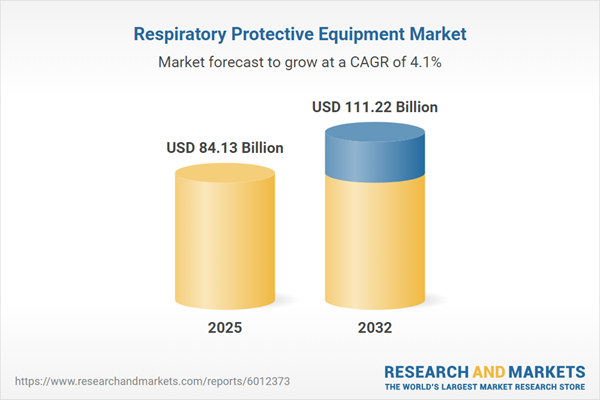Speak directly to the analyst to clarify any post sales queries you may have.
The Respiratory Protective Equipment Market is undergoing significant transformation as organizations worldwide respond to shifting safety requirements, technological innovation, and dynamic supply chains. This report delivers high-impact insights essential for decision-makers tasked with advancing operational resilience and capturing targeted growth opportunities in respiratory protection.
Market Snapshot: Respiratory Protective Equipment Market Outlook
The global market for respiratory protective equipment is poised for steady expansion, driven by heightened regulatory focus on occupational safety, rising awareness of airborne threats, and accelerated adoption of advanced filtration technologies. Market growth is shaped by continuous innovation, expanding industrial applications, and the evolution of distribution channels to enhance accessibility and responsiveness.
Scope & Segmentation of the Respiratory Protective Equipment Market
- Product Types: Filtering facepiece respirators (N95, N99, P100), powered air purifying respirators (loose and tight fitting), reusable respirators (full and half facepiece), and supplied air respirators (continuous and demand flow systems).
- End Users: Emergency services such as firefighters and rescue teams, healthcare settings including clinics and hospitals, industrial sectors across construction, manufacturing, and mining, as well as upstream and downstream oil and gas operations.
- Distribution Channels: Offline retail with direct sales and distributor networks, specialty PPE stores, online retail via eCommerce platforms, and manufacturer-hosted digital storefronts.
- Regional Coverage: Americas (North and Latin America), Europe, Middle East, Africa, and Asia-Pacific markets, each featuring differentiated regulatory frameworks and growth dynamics.
- Key Companies Analyzed: 3M Company, Honeywell International Inc., MSA Safety Incorporated, Drägerwerk AG & Co. KGaA, Avon Rubber plc, Moldex-Metric, Sundström Safety, Alpha Pro Tech, Gentex Corporation, and Uvex Safety Group.
- Technological Trends: Integration of miniaturized sensors for real-time air quality monitoring, adoption of advanced filtration media using nanofiber and electrostatic technology, and development of modular architectures for customizable protection.
Key Takeaways: Strategic Insights for Senior Decision-Makers
- Technological advancements—such as smart sensors and digital fit testing—are raising industry standards for protective efficacy and compliance, providing organizations with clear decision-making advantages.
- Collaborations between manufacturers, testing laboratories, and material science firms accelerate product development, certification processes, and market entry across varied regulatory regimes.
- User-centric design is vital, with lightweight construction, ergonomic features, and system compatibility driving higher adoption and frontline satisfaction in demanding environments.
- Expanding omnichannel distribution integrates traditional and digital pathways, boosting responsiveness and improving supply chain traceability for critical protective gear.
- Smaller innovators focus on sustainability, launching eco-friendly cartridges and streamlining packaging to align with emerging corporate responsibility priorities.
Tariff Impact: Navigating Regulatory Disruption
Recent tariff introductions on respirator components and finished goods have increased procurement and manufacturing costs. Industry leaders have adapted by optimizing supplier networks, exploring near-shoring for critical parts, and negotiating new logistics arrangements. These adaptive strategies help maintain secure supply chains and operational continuity amid evolving trade barriers.
Methodology & Data Sources
This report is founded on a blend of primary interviews with industry leaders and end users, supplemented by comprehensive secondary research from technical publications, regulatory documents, and company filings. Quantitative modelling and scenario analysis validate key trends, while continuous cross-verification ensures the credibility and depth of insights presented.
Why This Report Matters: Outcomes for Strategic Leadership
- Uncover actionable intelligence for investment prioritization, product innovation, and market entry strategies in respiratory protection.
- Benchmark your organization against competitors by leveraging segmentation and regional insights tailored to diverse regulatory and end-user landscapes.
- Sharpen risk mitigation with best-in-class practices for supply chain agility, compliance, and sustainable sourcing within the respiratory protective equipment space.
Conclusion
This report empowers senior leaders to drive operational excellence and secure long-term resilience in respiratory protective equipment. By aligning technological, regulatory, and strategic perspectives, organizations can position themselves at the forefront of evolving safety and market demands.
Additional Product Information:
- Purchase of this report includes 1 year online access with quarterly updates.
- This report can be updated on request. Please contact our Customer Experience team using the Ask a Question widget on our website.
Table of Contents
3. Executive Summary
4. Market Overview
7. Cumulative Impact of Artificial Intelligence 2025
List of Figures
Samples

LOADING...
Companies Mentioned
The key companies profiled in this Respiratory Protective Equipment market report include:- 3M Company
- Honeywell International Inc.
- MSA Safety Incorporated
- Drägerwerk AG & Co. KGaA
- Avon Rubber plc
- Moldex-Metric, Inc.
- Sundström Safety AB
- Alpha Pro Tech, Ltd.
- Gentex Corporation
- Uvex Safety Group GmbH & Co. KG
Table Information
| Report Attribute | Details |
|---|---|
| No. of Pages | 189 |
| Published | October 2025 |
| Forecast Period | 2025 - 2032 |
| Estimated Market Value ( USD | $ 84.13 Billion |
| Forecasted Market Value ( USD | $ 111.22 Billion |
| Compound Annual Growth Rate | 4.0% |
| Regions Covered | Global |
| No. of Companies Mentioned | 11 |









